Read the full press release from SubjectToClimate.
ESI Education Program Manager Sarah Meyers and Sustainability Education Postdoc Liz Potter-Nelson join MIT OpenCourseWare’s Chalk Radio podcast to discuss the Sustainability and Climate Change Across Learning Environments (SCALES) project, a curated repository of open-source, easily adaptable educational resources to support sustainability in the classroom and in the world.
In August 2021, the Ministry of Environment and Sustainable Development of Colombia selected Leticia, known as “El Corazón del Amazonas” (“The Heart of the Amazon”), as one of fourteen cities for its BiodiverCities Initiative, representing a national effort to support the creation of nature-positive urban development throughout the country.
However, though many appreciate the importance of this goal, how to achieve it remains challenging to uncover. For do we, as inheritors of the neoliberal city, have the capacity to articulate, or more importantly, even imagine what a biodiverse city could look like? Perhaps it is a place in which the built and natural environments coexist seamlessly? Or, is it one in which the threshold between the city and nature is defined–structurally, visually, or intangibly? And most importantly, how do we center equity in the process, creation, and proliferation of a BiodiverCity? These are some of the questions that the city of Leticia is grappling with and the MIT Environmental Solutions Initiative (ESI) and the Department of Urban Studies and Planning (DUSP) are tackling through the spring practicum Biodiversity and Cities: A Perspective in Colombian Cities.
“At the MIT ESI, we have a long-term commitment with Colombia and see the work of the students in the class as a starting point to identify potential research collaboration opportunities that could be further developed and carried out through the Natural Climate Solutions Program at ESI. We are interested in continuing partnering with the local institutions, and helping mobilize the resources needed for the implementation of projects that might come out of this academic exercise.”
– Marcela Angel, Research Program Director at ESI
In January 2023, a cohort of three researchers and twelve MIT students met in Bogotá, Colombia, to embark on a week-long field visit to Leticia with one primary goal: to begin to understand and document the inherent complexities of the city. Because although Leticia is a small town of just over 40,000 people, it holds a complex memory. Dating back to the 18th century, the city has been at the center of territorial conflicts with Peru, with which Colombia currently shares a river border, and with Brazil, with which Colombia currently shares a land border. Leticia is the manifestation of geopolitical extensions of control, which continue to shape how we understand and conceptualize the “Amazon” and will thus shape the effectiveness of any biodiversity conservation in the city.
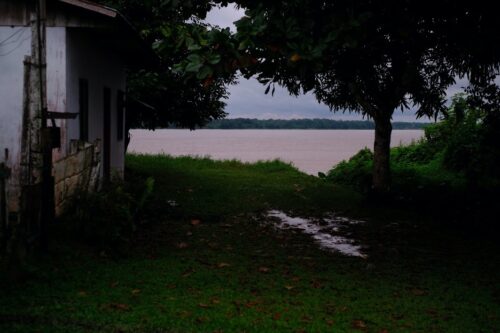
View of Peru across the Amazon River from Tabatinga. Photo: Azania
“The challenges of urbanization in the Amazon are not new–they are rooted in multiple cycles of colonization of the region, including most recently the infamous rubber boom that placed indigenous groups in practically forced labor. Recognizing this history is necessary to chart a sustainable path forward.”
– Marco Herndorn, MCP Candidate
The fieldwork consisted of a series of meetings and exchanges with on-the-ground partners, local change-makers, and government officials. Our group convened at SINCHI–El Instituto Amazónico de Investigaciones Científicas–early in the week to listen to the voices of several perspectives on biodiversity and development in Leticia. Mario López Castro, Coordinator of Urban Management at the Ministry of Environment, urged the team to “think of how to create harmonious ways of interacting with the environment.” Professor John Fernández highlighted the importance of investigating “harmony with biodiversity,” acknowledging that “cities are not conducive to greater biodiversity” and challenging us to view biodiversity as a portal to and through other socioeconomic issues. Juan Carlos Bernal of Colombia’s Regional Environmental Authority Corpoamazonia, articulated the disjointed manner with which each stakeholder was approaching the topic and shared thoughts on the political difficulties of working with Tabatinga, Leticia’s sister border city in Brazil. Franz Silva of Red Jovenes de Ambiente spoke on behalf of the 12,000 young people in Leticia, agreeing that the disconnected efforts were a disservice and calling for unity of purpose and collective responsibility. And finally, William Yucuna, Maloquero* of the Capiul indigenous community, reminded the audience that the spiritual aspect of biodiversity holds weight, calling for a change in mindset and respect to the indigenous peoples as the original stewards of the land. These voices held elements of hope, frustration, drive, and reserve. As the afternoon continued and the magnitude of the morning’s statements began to set in, the team began concretizing notes on the importance of collaboration and proposals for co-production and stakeholder cooperation began to emerge.
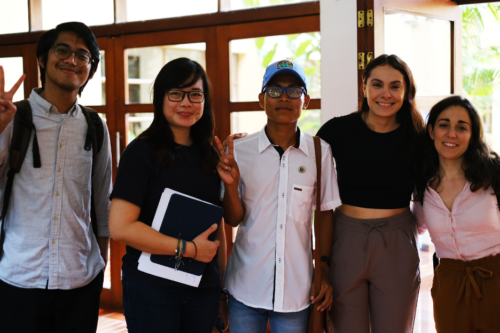
Members of the MIT cohort with community meeting participant, Franz Silva, of Red Jóvenes de Ambiente. From left to right: Rizki Rayani, Linh Trinh, Franz Silva, Patricia Garcia and Lidia Cano. Photo: Azania
“I believe it is fundamental for the government, activists, academics and the communities to find a way to work together towards the conservation of biodiversity and the environment. It takes all of us to accomplish this task.”
– Patricia Garcia, MCP Candidate
Over the course of the week, the group also had the opportunity to take a closer look at the relationship between the indigenous communities living in the city and its surrounding areas, co-facilitated by Juan Felipe Guhl, Program Director of Socio-Environmental Dynamics at SINCHI. Many of the indigenous communities stand firm in their role as historic stewards and their relationship of taking away and giving back to the land, but acknowledge the pressures they are facing in carrying on this role: some identify a lack of education, flooding, and deforestation as significant threats.
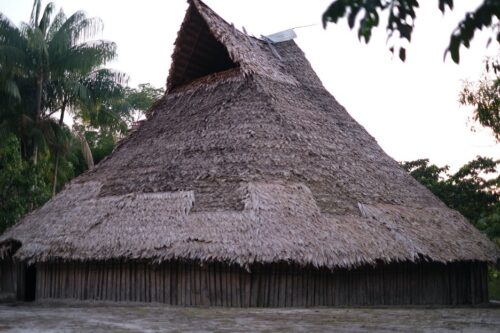
Maloca of Agustina in the peri-urban area of Leticia. Photo: Azania
La Isla de La Fantasia, a semi-autonomous agricultural community, represents a clear case of how the city’s development is confronted with historic stewardship and climatic and hydrological dynamics. Rubiela Pereira, President of the Community Board of Isla de la Fantasia, led our group through a visit around the island. Currently, the island experiences six months of a high water season and six months of a dry season. The flood season provides nutrients to the crops that are harvested in the dry season, and the settlement model is an example of traditional indigenous settlements built on stilts to co-exist with the water. Nevertheless, it also exacerbates rampant economic instability due to a short agricultural season and inadequate access to resources to safely navigate high waters. The residents also pointed out the saturation of the market across the creek that separates the island from Leticia, claiming it can be hard to sell products at a competitive price since there are so many vendors and relatively few consumers, further contributing to their financial hardships. Of the 1100 inhabitants of the island, the majority are experiencing extreme hardship due to underinvestment from the government and a lack of basic public services. Tensions rose when Fernanda Pérez, a representative from the mayor’s office, claimed it was difficult to justify municipal economic support for the island as it is in a flood risk zone and is considered neither a formal neighborhood nor an indigenous reserve. Residents were quick to point out that from their perspective, a lack of support from the government was due to “a lack of political will” and nothing more. As described by Erik Vergel, professor at Universidad de los Andes, these tensions are representative of a persistent contradiction between urban regulations and traditional settlement models in Amazonia, where the occupation of flood-prone areas for human settlements and agriculture have been traditional practices of indigenous communities but have not been appropriately incorporated into urban regulations and planning instruments due to the difficulty of mitigating risks in these areas. This has resulted in underinvestment in housing, infrastructure and lack of public services in these areas. The community of Isla de la Fantasia, whose members come from different indigenous communities in the region, is fighting to maintain residence on the land that they feel is rightfully theirs, in many ways to maintain their semi-rural indigenous practices and access to the city and to avoid a future similar to the indigenous of the Urban Maloca of Capiul, an urban Maloca that gathers indigenous peoples who have been displaced from their rural territories and are now living within the city of Leticia.
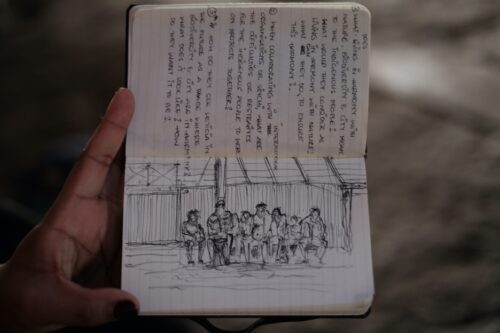
A sketch of the Urban Maloca of Capiul by Joris Komen, Architect, Doctoral Student in Computation at MIT. Photo: Azania
“To say we are not a community nor a neighborhood is the same as saying we don’t exist!”
– a member of La Isla de La Fantasia

La Isla de La Fantasia. Photo: Azania
The residents of La Isla de La Fantasia are not the only group attempting to leverage agriculture and biodiversity as economic drivers. A women-lead cooperative is actively engaged in urban agriculture near the Urumutú wetland and helping create awareness to preserve the land from informal occupation, and SINCHI is leading numerous efforts to support the use of local bio-products into value-add products such as copoazú, camu camu and acai, among others. However, as shared by Juan Carlos Bernal of Corpoamazonia, there is also an illegal extractive market for biodiversity, which exports prized, rare captures and killings of the exotic species that reside within the forest.
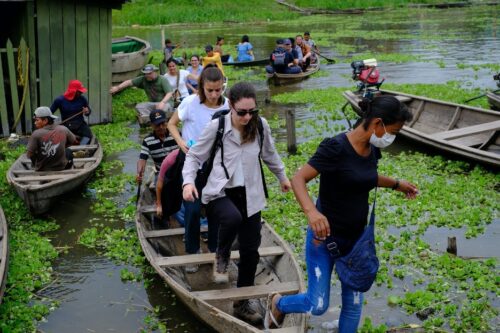
MIT delegation and collaborators returning from La Isla de La Fantasia. Photo: Azania
The creation and implementation of a BiodiverCity is a call for radical change, referring not to the speed but to the scale of the change. Throughout our visit, the complexity of a national program being implemented at a local scale was evident, with multiple actors focusing their efforts alongside a rather narrow view of cooperation. However, Professor Gabriella Carolini warns against naïve calls for cooperation, explaining that cooperation on the ground can be messy and cloudy and requires the clear inclusion of equity in project goals to have a chance of being successful. She explains that the co-production of these project goals is crucial, paying particular attention to who has the capacity, namely the time and resources, to even participate in the co-production of the project objectives. It remains clear that the city of Leticia is the target for growing speculation, and now is the opportunity to think critically about a short and long-term trajectory that could truly transform the city’s relationship with its inhabitants and biodiversity amidst rapid urbanization. However, what might limit the successful growth of the city, including whether the idea of growth can be divorced from outdated, capitalist definitions surrounding an increase in GDP and instead truly center the human experience, is yet to be determined. Only time will tell how the story in Leticia will unfold; in the meantime, our team will attempt to make suggestions that do not disrupt the natural rhythm of the heart of the Amazon.

Juan Carlos shows an indigenous mask using the Pirarucú fish scales as adornment. Photo: Azania
This experience is part of an ongoing course entitled Biodiversity and Cities: A perspective in Colombian Cities, led by ESI + DUSP faculty and researchers: Professor John E. Fernández, Professor Gabriella Carolini, Marcela Angel, Norhan Bayomi, and Alessandra Fabbri.
* Maloquero is an indigenous title for the owner of the Maloca, a person who holds responsibilities in guiding the community.
In November 2021, Ziyuan “Zoey” Zhu attended an event at MIT hosted by ESI, the MIT Media Lab, and the Involved Group, a collection of electronic music record labels. The event, “Artists and Scientists Together on Climate Solutions,” asked how the music industry can both improve its own sustainability, and be a force for environmental change among the large and tight-knit communities of devoted music fans.
After the event, Zhu introduced herself to Anna Johnson, the Involved Group’s Sustainability and Environment Officer, who connected her to Norhan Bayomi, a postdoctoral associate at ESI who also produces dance music with Involved Group label Anjunabeats under the stage name Nourey. At the time, Zhu was an MIT master’s student in architecture studies and computer science. She had already been thinking about how emerging technology could draw people to engage with sustainability questions; most recently, she had done research for the MIT Office of Sustainability probing students on their understanding of the circular economy on campus.

Ziyuan “Zoey” Zhu ’22, software designer at IDEO and MIT master’s graduate in architecture studies and computer science
“And Anjunabeats was thinking about the same things, how to make sustainability more calculatable and interactive in their events,” Zhu says. “So Norhan asked, why don’t we propose an event with Anjunabeats, so we can get creative with people’s interaction with climate issues?”
This, as it turned out, would be the first on-the-ground project of the MIT Climate Machine, an ESI program uniting climate knowledge with arts and culture. Anjunabeats agreed to collaborate on an interactive experience at one of their biggest upcoming summer festivals, the Group Therapy Weekender in Washington State. Zhu was brought into the small team that would develop the project.
The Climate Machine’s first project had a narrow focus: the environmental impact of the Weekender festival itself. “We wanted to know how people understand different aspects of music events in terms of sustainability,” says Zhu. “And also, how music fans see their personal impact on climate change at live events. From the perspectives of waste, carbon emissions, and energy consumption.”
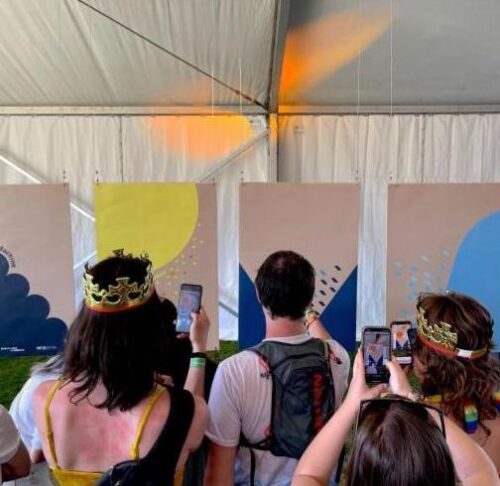
Festival goers at the Group Therapy Weekender Festival in Washington interact with the MIT Climate Machine’s AR installation
Sara Wilson, a PhD candidate in the MIT Department of Mechanical Engineering with an interest in behavioral science, wrote a survey to gauge concert goers’ understanding of these issues. But the team felt much more was needed to get people excited to participate. Zhu, who had been working with augmented reality (AR) programs that combine real physical spaces with digital interactions, got to work on constructing a larger AR story to surround the quiz.
The resulting installation took the form of abstract art pieces that festival fans could walk through, unlocking new aspects of the festival’s sustainability story on their phones. “So one is about the site, about the biodiversity of the Gorge, because the festival was happening at the Gorge which is this beautiful venue near Seattle,” says Zhu. “And so we used information about the local diversity, and how might the music festival impact the local diversity. But also, how people can do something good that could compensate for this.” Other pieces in the sequence tackled topics like the festival’s energy use, the waste it generated, and transportation to and from the site.
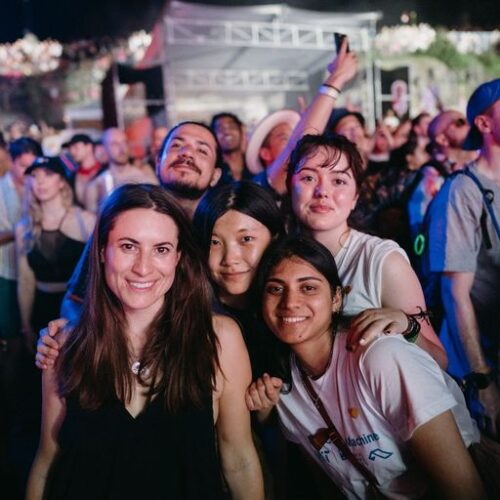
The MIT Climate Machine team at the Gorge: Adam Nacov (top L), Sara Wilson (top R), Supreetha Krishnan (bottom R), Zoey Zhu (center) and Anna Johnson of the Involved Group (bottom L)
Only after absorbing that context were participants asked how they think about their own impact. And their survey responses were used to create a collaborative art piece, as people were sorted into different climate identities based on their interests—an “energy hero,” an “emissions detective.” These identities became abstract collections of shapes and colors that were collectively projected into a new visualization, so visitors could take in the full scope of environmental perspectives present at the festival.
“We don’t want to use technology for the sake of technology,” says Zhu. “We were asking, how could we use the technology to create stories around climate change that can inspire people in their daily life?”
After surveying users, the Climate Machine team and the Involved Group were encouraged enough to bring the experience to more festivals in London and Los Angeles over the course of 2022. At each new event, the technology was tweaked to make it more engaging and more useful outside the gates of the festival.
By the end of the year, participants were getting customized tips on how they can do more good for the climate based on their own concerns. They also received a digital avatar who would appear in AR installations and could be shared on social media. “We’ve kept making it more customized, more clickable, more interactive,” says Zhu. “Because for music events, fans have high expectations, and want to play with it.”
Climate Machine “avatars” at the Anjunabeats AGBT500 event in Los Angeles
Zhu has since graduated MIT, and is now a software designer at IDEO, a design innovation firm. But she’s kept in touch with the Climate Machine team, continuing to contribute to follow-on projects and bringing in additional tools like generative AI to tell customized climate change stories.
“We want to extend it,” she says. “Because we’ve found that climate change is something where you really need to communicate with people, and we want to use a more interactive way to tell the climate story and make things more actionable.”
In February 2022, five years after the city of Mocoa, Colombia suffered a devastating landslide, ESI and a broad group of local and international partners launched the project Drones for Equitable Climate Change Adaptation (DECCA) to help prepare the city for future disasters. The DECCA project aims to deploy unmanned aerial vehicles (UAVs or drones) to explore the use of new technologies to provide Mocoa with an effective and robust landslide monitoring system, combined with local stakeholder engagement.
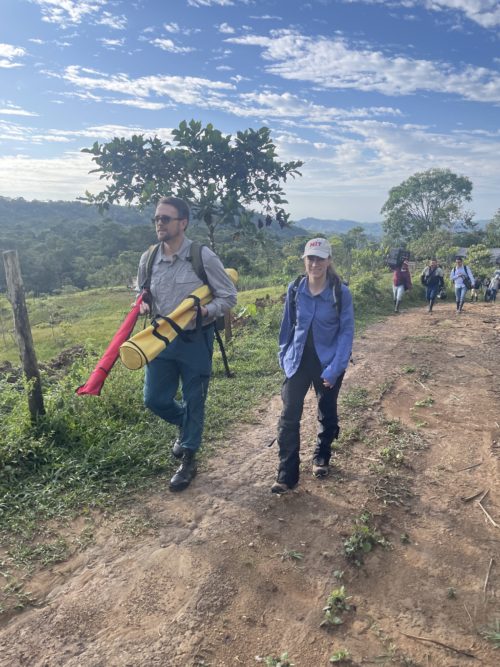
Members of the DECCA team arrive at the flight test site in Mocoa. Photo: Adam Kersnowski
Now, a delegation of seven researchers and students has returned from Mocoa after launching their first pilot flight in the field. The delegation—from ESI and project partners Lincoln Laboratories, AirWorks, the Pratt Institute Graduate Center for Planning and the Environment, and CAF Development Bank of Latin America and the Caribbean—worked hand-in-hand for a week with a team from on-the-ground partner Corpoamazonia, both to test out the UAVs and to reinforce the community relationships needed to realize the project. During their weeklong visit, the DECCA members held a series of workshops to increase local awareness, solicit feedback for a series of communication tools the project will use to keep Mocoa’s citizens informed, and strengthen local technical capacities to take part in landslide risk management.
Flying drones in the cloud-covered and forested mountains of the Andean-Amazon piedmont is not a trivial challenge. “This has truly been the most impactful project I’ve ever been part of,” said Adam Kersnowski, AirWorks co-founder and Chief Evangelist and DECCA’s lead flight operations expert. “We made great progress in overcoming the technical challenges of flying drones in this extreme terrain, but our journey is far from over.” Kersnowski used his time in Mocoa to help train Corpoamazonia’s pilot and data collection team; over the next few months these pilots will carry out increasingly complicated flight missions. “As this project moves forward, we’ll continue to help the team build their confidence and capabilities in data collection, which is crucial to protecting the people of Mocoa from future landslides.”
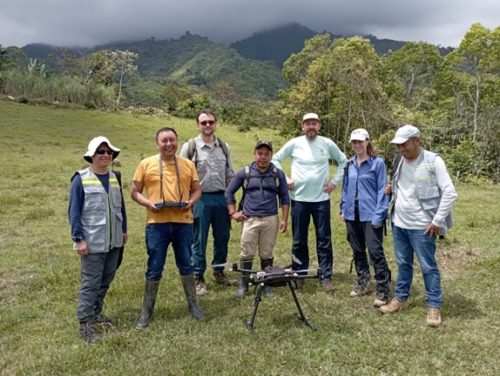
Staff from Corpoamazonia´s data collection team, Airworks, Lincoln Laboratories, ESI and the Colombian Geological service during the launch of the pilot flight. Mocoa, Colombia, January 25, 2023. Photo: Duber Rosero.
These test flights will help the DECCA team refine the workflow and flight plans for collecting data to create digital terrain models of the bare earth. The project is using machine learning to develop a landslide susceptibility model based on these data and key hydrological, geological and geomorphological features that can be extracted from the models.
At the same time, the team is building the community network needed to give this risk detection system the greatest impact in Mocoa. Under the leadership of Juan Camilo Osorio, professor at Pratt Institute’s Graduate Center for Planning and the Environment and PhD candidate at MIT, the project partners have been working with community leaders to establish a community researchers network (CRN) to participate in the three pillars of the project: technical infrastructure, engagement and capacity building, and knowledge sharing infrastructure.
As Edgar Torres, a member of the CRN, explained in his presentation to the community during a public event, “The [CRN] is designed to strengthen the participation of individuals, groups or communities and represent their interests, and in coordination with the institutional framework, use the project as an opportunity for dialogue to discuss their needs, establish collective priorities and discuss strategies to achieve responses that attend the needs of the community.”

Members of the Community Researchers Network facilitate a visioning session. Mocoa, Colombia, January 26, 2023. Photo: Madeline Chmielinski
During the project team’s visit to Mocoa, the CRN with the support of Corpoamazonia convened and co-facilitated a series of local events: a public meeting and visioning workshop, a conference, and a co-design workshop to discuss the evolving understanding of the risk of landslides. These events not only proved the convening capacity of the CRN, but more importantly, confirmed the interest of the community to engage with more sophisticated data in their understanding of risks. This buy-in and active engagement will be needed to help city officials and community members make planning decisions that will make Mocoa more resilient to future disasters.
To that end, the DECCA team has begun developing an online platform to share the results and process of the project with the citizens and key institutions in Mocoa. An early stage prototype of this platform was shared with stakeholders to gain feedback for the design process.
“Building on ESI’s five-year engagement in Mocoa, this latest visit represented a new opportunity to gain perspective and re-focus the research efforts in ways that are aligned with local priorities and the ongoing risk management efforts in Mocoa,” said Marcela Angel, Research Program Director at ESI and director of the project. “Most importantly, we were able to identify new research and collaboration opportunities consolidating an agenda for future work in Mocoa.”
These opportunities include participatory data collection and crowdsourced efforts to collect cultural and biological information, which will complement DECCA’s susceptibility analysis. DECCA also aims to develop courses for local students in the use of drones for climate risks monitoring, which will expand the use of the project’s technological infrastructure. And the DECCA team and community members will work together to elevate the role of the CRN as a regional knowledge sharing network.
Taken together, these actions set up a robust pathway for the continuation of a partnership that has been bridging the gaps of technology development and community engagement for climate risk monitoring in Colombia.
The DECCA project is supported by the Ministry of Environment and Sustainable Development of Colombia, with the economic support of the Global Environmental Facility and under implementation through CAF Development Bank of Latin America and the Caribbean. Questions about DECCA can be directed to Marcela Angel at marcelaa@mit.edu.

A public meeting at Corpoamazonia´s auditorium. Mocoa, Colombia, January 25, 2023. Photo: Marcela Angel
As plastic pollution continues to mount, with growing risks to ecosystems and wildlife, manufacturers are beginning to make ambitious commitments to keep new plastics out of the environment. A growing number have signed onto the U.S. Plastics Pact, which pledges to make 100 percent of plastic packaging reusable, recyclable, or compostable, and to see 50 percent of it effectively recycled or composted, by 2025.
But for companies that make large numbers of small, disposable plastics, these pocket-sized objects are a major barrier to realizing their recycling goals.
“Think about items like your toothbrush, your travel-size toothpaste tubes, your travel-size shampoo bottles,” says Alexis Hocken, a second-year PhD student in the MIT Department of Chemical Engineering. “They end up actually slipping through the cracks of current recycling infrastructure. So you might put them in your recycling bin at home, they might make it all the way to the sorting facility, but when it comes down to actually sorting them, they never make it into a recycled plastic bale at the very end of the line.”
Now, a group of five consumer products companies is working with MIT to develop a sorting process that can keep their smallest plastic products inside the recycling chain. The companies — Colgate-Palmolive, Procter & Gamble, the Estée Lauder Companies, L’Oreal, and Haleon — all manufacture a large volume of “small format” plastics, or products less than two inches long in at least two dimensions. In a collaboration with Brad Olsen, the Alexander and I. Michael Kasser (1960) Professor of Chemical Engineering; Desiree Plata, an associate professor of civil and environmental engineering; the MIT Environmental Solutions Initiative; and the nonprofit The Sustainability Consortium, these companies are seeking a prototype sorting technology to bring to recycling facilities for large-scale testing and commercial development.
Working in Olsen’s lab, Hocken is coming to grips with the complexity of the recycling systems involved. Material recovery facilities, or MRFs, are expected to handle products in any number of shapes, sizes, and materials, and sort them into a pure stream of glass, metal, paper, or plastic. Hocken’s first step in taking on the recycling project was to tour one of these MRFs in Portland, Maine, with Olsen and Plata.
“We could literally see plastics just falling from the conveyor belts,” she says. “Leaving that tour, I thought, my gosh! There’s so much improvement that can be made. There’s so much impact that we can have on this industry.”
Hocken always knew she wanted to work in engineering. Growing up in Scottsdale, Arizona, she was able to spend time in the workplace with her father, an electrical engineer who designs biomedical devices. “Seeing him working as an engineer, and how he’s solving these really important problems, definitely sparked my interest,” she says. “When it came time to begin my undergraduate degree, it was a really easy decision to choose engineering after seeing the day-to-day that my dad was doing in his career.”
At Arizona State University, she settled on chemical engineering as a major and began working with polymers, coming up with combinations of additives for 3D plastics printing that could help fine-tune how the final products behaved. But even working with plastics every day, she rarely thought about the implications of her work for the environment.
“And then in the spring of my final year at ASU, I took a class about polymers through the lens of sustainability, and that really opened my eyes,” Hocken remembers. The class was taught by Professor Timothy Long, director of the Biodesign Center for Sustainable Macromolecular Materials and Manufacturing and a well-known expert in the field of sustainable plastics. “That first session, where he laid out all of the really scary facts surrounding the plastics crisis, got me very motivated to look more into that field.”
At MIT the next year, Hocken sought out Olsen as her advisor and made plastics sustainability her focus from the start.
“Coming to MIT was my first time venturing outside of the state of Arizona for more than a three-month period,” she says. “It’s been really fun. I love living in Cambridge and the Boston area. I love my labmates. Everyone is so supportive, whether it’s to give me advice about some science that I’m trying to figure out, or just give me a pep talk if I’m feeling a little discouraged.”
A lot of plastics research today is devoted to creating new materials — including biodegradable ones that are easier for natural ecosystems to absorb, and highly recyclable ones that hold their properties better after being melted down and recast.
But Hocken also sees a huge need for better ways to handle the plastics we’re already making. “While biodegradable and sustainable polymers represent a very important route, and I think they should certainly be further pursued, we’re still a ways away from that being a reality universally across all plastic packaging,” she says. As long as large volumes of conventional plastic are coming out of factories, we’ll need innovative ways to stop it from piling onto the mountain of plastic pollution. In one of her projects, Hocken is trying to come up with new uses for recycled plastic that take advantage of its lost strength to produce a useful, flexible material similar to rubber.
The small-format recycling project also falls in this category. The companies supporting the project have challenged the MIT team to work with their products exactly as currently manufactured — especially because their competitors use similar packaging materials that will also need to be covered by any solution the MIT team devises.
The challenge is a large one. To kick the project off, the participating companies sent the MIT team a wide range of small-format products that need to make it through the sorting process. These include containers for lip balm, deodorant, pills, and shampoo, and disposable tools like toothbrushes and flossing picks. “A constraint, or problem I foresee, is just how variable the shapes are,” says Hocken. “A flossing pick versus a toothbrush are very different shapes.”
Nor are they all made of the same kind of plastic. Many are made of polyethylene terephthalate (PET, type 1 in the recycling label system) or high-density polyethylene (HDPE, type 2), but nearly all of the seven recycling categories are represented among the sample products. The team’s solution will have to handle them all.
Another obstacle is that the sorting process at a large MRF is already very complex and requires a heavy investment in equipment. The waste stream typically goes through a “glass breaker screen” that shatters glass and collects the shards; a series of rotating rubber stars to pull out two-dimensional objects, collecting paper and cardboard; a system of magnets and eddy currents to attract or repel different metals; and finally, a series of optical sorters that use infrared spectroscopy to identify the various types of plastics, then blow them down different chutes with jets of air. MRFs won’t be interested in adopting additional sorters unless they’re inexpensive and easy to fit into this elaborate stream.
“We’re interested in creating something that could be retrofitted into current technology and current infrastructure,” Hocken says.
“Recycling is a really good example of where pre-competitive collaboration is needed,” says Jennifer Park, collective action manager at The Sustainability Consortium (TSC), who has been working with corporate stakeholders on small format recyclability and helped convene the sponsors of this project and organize their contributions. “Companies manufacturing these products recognize that they cannot shift entire systems on their own. Consistency around what is and is not recyclable is the only way to avoid confusion and drive impact at scale.
“Additionally, it is interesting that consumer packaged goods companies are sponsoring this research at MIT which is focused on MRF-level innovations. They’re investing in innovations that they hope will be adopted by the recycling industry to make progress on their own sustainability goals.”
Hocken believes that, despite the challenges, it’s well worth pursuing a technology that can keep small-format plastics from slipping through MRFs’ fingers.
“These are products that would be more recyclable if they were easier to sort,” she says. “The only thing that’s different is the size. So you can recycle both your large shampoo bottle and the small travel-size one at home, but the small one isn’t guaranteed to make it into a plastic bale at the end. If we can come up with a solution that specifically targets those while they’re still on the sorting line, they’re more likely to end up in those plastic bales at the end of the line, which can be sold to plastic reclaimers who can then use that material in new products.”
“TSC is really excited about this project and our collaboration with MIT,” adds Park. “Our project stakeholders are very dedicated to finding a solution.”
To learn more about this project, contact Christopher Noble, director of corporate engagement at the MIT Environmental Solutions Initiative.
In spring 2021, the MIT Environmental Solutions Initiative (ESI) created the ESI Journalism Fellowships to support journalists from around the United States in creating deeply reported news projects for local newsrooms on the impacts of climate change, and the transition to a clean economy, in their readers’ own regions and communities.
Today, we are pleased to announce our second class of ESI Journalism Fellows. These five outstanding reporters span the country from New England to the Southwest, bringing local perspectives, values and angles to the big story of our changing climate. With support from their newsrooms, ESI and MIT, our new Fellows will spend the coming months reporting out longform or serial projects for publication this year.
Our 2023 Journalism Fellows are:
The ESI Journalism Fellowships were created to provide additional resources, scientific expertise and reporting time to the local journalists and newsrooms who know their audiences best, for high-impact climate news projects that touch directly on their readers’ lives and experiences. You can read more about our first class of Journalism Fellows and their projects in our 2021 Impact Report, or learn more about the Fellowship and our new cohort of reporters on the ESI website.
The MIT Environmental Solutions Initiative (ESI) has partnered with SubjectToClimate to introduce a help desk called “ClimateSocrates.”
ClimateSocrates is an interactive support center that offers up to date information about climate science and pedagogical strategies. Teachers searching for lessons plans and other climate education materials from SubjectToClimate can find content in a simple chatbot interaction, which will address common foundational questions on climate change so that they feel ready to teach the topic and answer their students’ questions in class. Content is sourced from the MIT Climate Portal, an ESI project that provides short, easy-to-read explainers and answers on important climate topics with the support of MIT faculty, researchers, and other subject matter experts.
On December 14th, 2022, the Environmental Solutions Initiative launched the MIT-ESI Climate Justice Program at an afternoon workshop with MIT faculty and staff. Led by myself and ESI Director John Fernandez, workshop participants explored how to develop an Institute-wide, cross-disciplinary, engaged research and teaching agenda focused explicitly on urgent topics related to climate justice. The workshop served as a first opportunity to articulate the program’s core commitments, brainstorm priority pilot projects, identify funding needs and pathways for funding, and lay the groundwork for near and long-term collaborations.
ESI’s Climate Justice Program is grounded in a commitment to partner with communities most impacted by climate change and the transition to a decarbonized society. The program will include perspectives from a wide range of stakeholders and rights holders including various Indigenous, Afro-descendant, and historically marginalized communities.
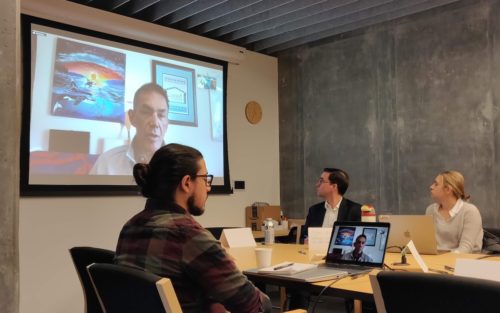
Jay Julius W’tot Lhem, former Lummi tribal chairman and president of Se’Si’Le, joins the workshop virtually.
Three Indigenous climate justice leaders kicked off our first workshop by offering their insights and expertise in support of this emerging program. Donna Chavis, Lumbee community leader and Climate & Energy Justice Program Manager with Friends of the Earth U.S., spoke about the importance of tribal self-determination. Donna also shared her experiences in the successful effort to prevent construction of a natural gas pipeline in her region. Duke University Professor and Lumbee tribal member Dr. Ryan Emanuel emphasized the importance of co-creation of knowledge and solutions between academia and impacted communities. Jay Julius W’tot Lhem, former Lummi tribal chairman and president of the Indigenous-led nonprofit organization Se’Si’Le, shared the importance of Indigenous philosophies of interrelatedness and spoke of the struggle to manage the interconnected threats of natural and cultural extinction facing Pacific salmon and tribal communities in the Pacific Northwest. Se’Si’Le Executive Director Dr. Kurt Russo also shared insights on the importance of cultural specificity and respect in any work on climate justice.

Faculty and staff from a wide variety of MIT departments, labs and centers participated in the workshop launching the Climate Justice Program.
This first workshop focused on identifying the greatest needs for advancing climate justice, understanding how the most impacted communities are working toward climate justice, and the specific contribution that MIT can make to this vast field. The workshop identified relevant work already underway at MIT and opportunities for collaboration among faculty and staff on climate justice related topics. We explored community-led and community-engaged models for climate justice research and teaching. We also began to articulate year one priorities and pathways for funding and building further collaborative research and teaching agendas. Faculty and staff from the Departments of Urban Studies and Planning, Anthropology, Civil and Environmental Engineering, and Nuclear Science and Engineering; the Program on Science, Technology, and Society; the Sloan Sustainability Initiative; the Office of the Vice President for Research; MIT OpenCourseWare; the MIT Climate & Sustainability Consortium; the MIT Office of Sustainability; and postdocs, students, and staff from ESI contributed to the discussion.
We welcome further faculty and staff involvement as we continue to shape this new program. Members of the MIT community are invited to attend a second workshop on Thursday, January 19th. This workshop is supported by an MIT Climate Nucleus IAP award. If you would like to participate, please register for the workshop by January 12th. If you would like to be involved, but you are unable to attend the workshop, please contact me, Briana Meier, at bkmeier@mit.edu.
In a 2022 white paper, Protecting and Enhancing Natural Carbon Sinks: Natural Climate and Community Solutions, MIT researchers introduced the concept of “Natural Climate and Community Solutions” as a framework for socially beneficial climate action and biodiversity conservation in carbon-rich ecosystems. Unpacking different aspects of this concept was the intellectual motivation for a recent conference in Brazil.
The 4th International Symposium on Environmental Management and Climate Change (in Portuguese: 4ºSimpósio Internacional sobre Gestão Ambiental e Mudanças Climáticas – 4ºSIMGAMC), co-organized by the MIT Environmental Solutions Initiative (ESI) and hosted by the Centro de Pesquisa da Universidade Positivo (CPUP), was held in Curitiba, Brazil, from December 4th to 7th.
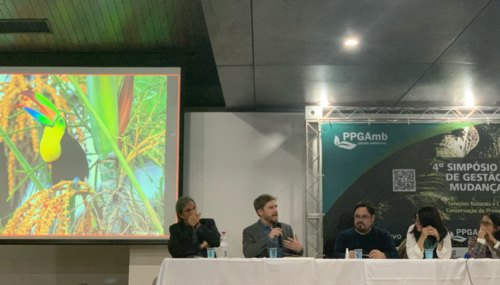
Presenters at the 4ºSIMGAMC event discuss “monitoring to support conservation and management of natural resources and the well-being of local communities”
The event included round tables, lectures, workshops, posters, and oral presentations of original research, with an emphasis on paths for nature conservation in Latin American tropical forests aligned with socio-economic priorities of traditional populations and other links in society. Topics included governance for the conservation of transboundary ecosystems, monitoring to support conservation and management of natural resources and the well-being of local communities, the role of community empowerment in environmental management, bioeconomies as models of sustainable development, and urban planning for human settlements in carbon-rich and ecologically sensitive regions.
The symposium convened representatives from research institutions, universities, non-governmental and governmental organizations, community organizations and companies from 5 different countries in the Americas to present their research and field strategies and to share reflections on relevant socio-environmental issues for Latin America. Participating organizations included National Institute for Space Research INPE (Brazil); National Research Institute of the Amazon INPA (Brazil); UN-FAO REDD+ Latin America; Amazonian Cooperation Treaty Organization ACTO; Amazonic Institute of Scientific Research SINCHI (Colombia); Interdisciplinary Centre of Marine and Environmental Research CIIMAR; University of Porto (Portugal); Alexander von Humboldt Institute of Biological Resources IAvH (Colombia); and University of Santiago (Chile), among others.
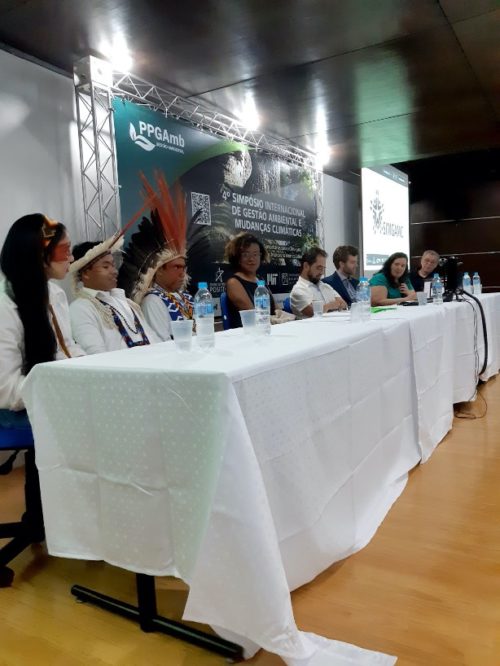
A symposium panel discusses “the role of community empowerment in environmental management”
Researchers and students from MIT had wide participation across all panels. Prof. John Fernández, Director of the ESI, highlighted the challenges of decision making under tradeoffs and the shifting role of academia to address global environmental challenges. Alessandra Fabbri, a doctoral student at the MIT School of Architecture and Planning, and Angelica Mayolo, a Fellow at ESI, discussed how conservation efforts for transboundary ecosystems open new opportunities for integration of multiple and overlapping levels of governance, in which many actors operate within different spaces. Evan Fricke, a research scientist at the MIT Terrer Lab, discussed how biodiversity amplifies the functionality of ecosystems as natural carbon sinks (Evan Fricke, MIT Terrer Lab). Natalia Mosquera of the MIT Community Innovators Lab argued that economic democracy and pluralist models of development support the restoration of ecosystems in tropical rainforests. And ESI Research Program Director Marcela Angel and doctoral student Joris Komen of the School of Architecture and Planning presented on the main challenges and indigenous development lessons for cities in biodiversity hotspots and carbon-rich regions .
UP PPGAmb Professors Cíntia Mara Ribas de Oliveira and John J. Loomis, together with ESI’s Marcela Angel and Alessandra Fabbri, led the organization of the event.
In addition to sharing knowledge, the event provided a fruitful environment to promote new collaborations and partnerships. Capturing the essence of the event, Olívio Jekupé of the Guarani Nation in Paraná, Brazil, highlighted that multi-stakeholder partnerships are necessary, since “we live the fight” and “we also have knowledge to share, because we too are worried about the environment”. For Kanamashi of the Yawanawa Nation in the Amazon state of Acre, Brazil, knowledge sharing and communication are fundamental to growth and development, and she hopes members of the research network have an opportunity to visit her territory, because “our territory needs to be seen.”
The event was supported by the Institute of Ecological Research IPÊ , Mater Natura Institute of Environmental Studies, and the Wildlife and Environmental Education Research Society SPVS, in addition to the Support Program for Events in the Country (PAEP) of the Brazilian Ministry for Education and the Brazilian state Parana’s Research Institution, Fundação Araucária.
UP social media handles: website, LinkedIn, Facebook, Instagram, and YouTube.
ESI Research Program Director Marcela Angel speaks with El País about nature-based approaches to mitigating climate change.